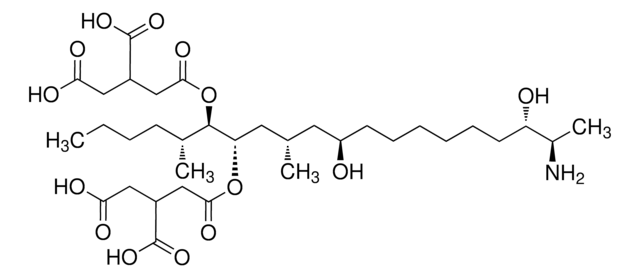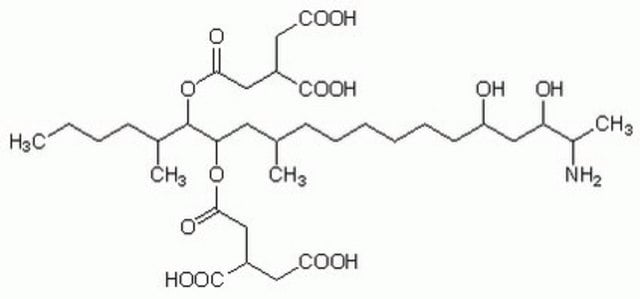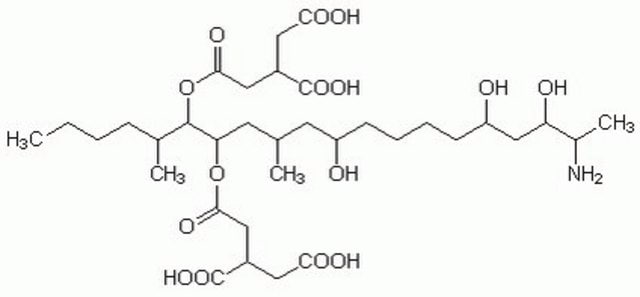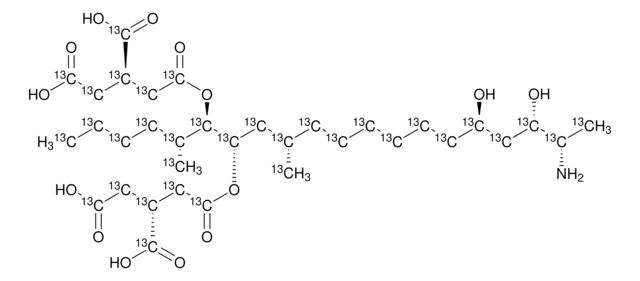F3771
Fumonisin B2 from Fusarium moniliforme
sphingosine N-acyltransferase inhibitor
Synonim(y):
FB2, Fumonisin B2
About This Item
Polecane produkty
pochodzenie biologiczne
Fusarium sp. (Fusarium moniliforme)
Próba
≥96% (TLC)
Postać
powder
rozpuszczalność
methanol: 10 mg/mL, clear, colorless to faintly yellow
temp. przechowywania
−20°C
ciąg SMILES
CCCCC(C)C(OC(=O)CC(CC(O)=O)C(O)=O)C(CC(C)CCCCCCC(O)CC(O)C(C)N)OC(=O)CC(CC(O)=O)C(O)=O
InChI
1S/C34H59NO14/c1-5-6-12-21(3)32(49-31(43)18-24(34(46)47)16-29(40)41)27(48-30(42)17-23(33(44)45)15-28(38)39)14-20(2)11-9-7-8-10-13-25(36)19-26(37)22(4)35/h20-27,32,36-37H,5-19,35H2,1-4H3,(H,38,39)(H,40,41)(H,44,45)(H,46,47)
Klucz InChI
UXDPXZQHTDAXOZ-UHFFFAOYSA-N
Szukasz podobnych produktów? Odwiedź Przewodnik dotyczący porównywania produktów
Opis ogólny
Zastosowanie
- as a standard for the detection of FB2 by high performance liquid chromatography (HPLC) in corn based food products
- used as standard in the determination of fumonisin B1 and B2 in corn and corn-based products by high-performance liquid chromatography
- as a standard in the determination of mycotoxins by HPLC
Działania biochem./fizjol.
produkt powiązany
Hasło ostrzegawcze
Warning
Zwroty wskazujące rodzaj zagrożenia
Zwroty wskazujące środki ostrożności
Klasyfikacja zagrożeń
Carc. 2
Kod klasy składowania
11 - Combustible Solids
Klasa zagrożenia wodnego (WGK)
WGK 3
Temperatura zapłonu (°F)
Not applicable
Temperatura zapłonu (°C)
Not applicable
Środki ochrony indywidualnej
Eyeshields, Faceshields, Gloves, type P3 (EN 143) respirator cartridges
Certyfikaty analizy (CoA)
Poszukaj Certyfikaty analizy (CoA), wpisując numer partii/serii produktów. Numery serii i partii można znaleźć na etykiecie produktu po słowach „seria” lub „partia”.
Masz już ten produkt?
Dokumenty związane z niedawno zakupionymi produktami zostały zamieszczone w Bibliotece dokumentów.
Klienci oglądali również te produkty
Nasz zespół naukowców ma doświadczenie we wszystkich obszarach badań, w tym w naukach przyrodniczych, materiałoznawstwie, syntezie chemicznej, chromatografii, analityce i wielu innych dziedzinach.
Skontaktuj się z zespołem ds. pomocy technicznej














